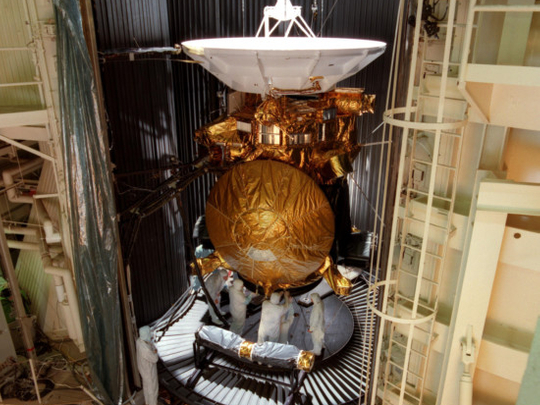
Cassini — the robotic spacecraft that orbited Saturn — met its end last Friday when it entered the atmosphere of Saturn after a 13-year odyssey exploring the gas giant’s spectacular rings, atmosphere and moons.
The planned demise occurred as Cassini ran out of fuel, and came shortly after the 40th anniversary of the launch of Voyager 1. This is an auspicious coincidence because it was the findings from Voyager 1 — and its sister ship, Voyager 2 — that stimulated the interest that made the Cassini trek possible.
Voyager 1’s 1980 flyby of Saturn’s largest moon, Titan, revealed a world enveloped in a dense atmosphere of nitrogen and methane — thick with organic hazes hiding the surface from view. Voyager 2 further whetted the appetite for Saturn probes after it sent back images of a bright, smooth surface on the tiny moon of Enceladus in 1981, raising questions about whether it might be volcanic. These were the mysteries that propelled the Cassini mission, for which I worked as an interdisciplinary scientist developing and analysing its science for 27 years. To get a better glimpse of Titan, the European Space Agency designed the Huygens probe, which the Cassini spacecraft carried until it detached and descended into Titan’s atmosphere in 2005.
What Cassini and its Huygens probe found was beyond all scientific expectations. The surface of Titan hosts Earth-like valleys, river channels, lakes and seas, through which flows not water but liquid methane — perfectly stable under the frigid conditions a billion miles from the sun. Cassini did more than just discover these dynamic features; it explored them. Instruments on Cassini remotely sensed the depth of Titan’s seas and measured their composition, confirming the liquid methane and finding a hint of other organic molecules as well. The Huygens probe got up close and personal with the rounded pebbles at its landing site — remnants of the floods of liquid methane coursing out of the hills behind it.
At Enceladus, Cassini plunged through plumes of gas, ice and dust spewing out of cracks near the tiny moon’s south pole, sampling the water vapour and icy grains with its instruments. From the plumes, Cassini found carbon-bearing molecules, salts and chemical signposts of hot water reacting with rock deep in the region of the plume’s source, beneath the icy moon’s surface.
Microbial life
Thanks to Cassini, we now know that the Saturn system has at least three confirmed reservoirs of stable liquids, including water oceans within Enceladus and Titan and a system of methane lakes and seas on Titan’s surface. There are also hints of oceans under other Saturnian moons. Of the three moons in our solar system with confirmed water oceans — Enceladus, Titan and Jupiter’s moon Europa — Enceladus has emerged as a special, primary target. Cassini’s sampling of the robust plume shows that its source — the subsurface ocean — possesses the basic requirements for sustaining microbial life. For the first time in the exploration of the solar system, we have found an environment where life could exist now. Cassini didn’t have instruments of sufficient analytic power to tell us if life did exist on the tiny moon, but a new generation of instruments — successors to those on Cassini — can do so simply by flying through the plume repeatedly as Cassini did. Such a mission could be a relatively inexpensive way to give us our earliest chance to answer the age-old question of whether life exists on other worlds. The methane seas on Titan similarly beckon us to question whether a form of life could develop and evolve in a liquid profoundly different from water. Its surface seas allow us to test the limits of life but would require landing on and sampling the seas — the first nautical expedition on another world
Nasa is developing a spacecraft to explore Europa by performing more than 40 close flybys from Jupiter’s orbit. The mission — named Europa Clipper — is superbly instrumented and, by the mid-2020s, could provide detailed information about Europa’s vast ocean — twice the volume of Earth’s — to tell us whether it is habitable and (if plumes exist as on Enceladus) easily accessible. This mission would hopefully be followed by a lander to search for deposits on Europa’s surface harbouring chemical signatures of life. What’s next for the Saturn system and its dynamic, intriguing moons? With limited resources, Nasa must make choices among the various ideas for future exploration. But the annual cost of even a modest programme of missions to these moons is small compared to the total Nasa budget. A billion miles across space, ocean worlds orbiting the ringed planet beckon us to come again — this time to find out whether they hide gardens of unearthly microbial delights.
— Washington Post
Jonathan Lunine is the David C. Duncan professor in the Physical Sciences and director of Cornell Centre for Astrophysics and Planetary Science at Cornell University.









